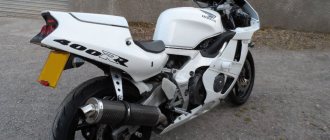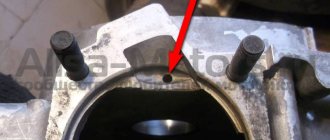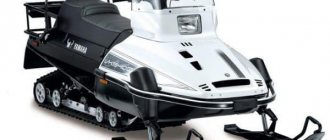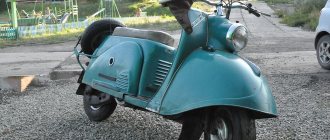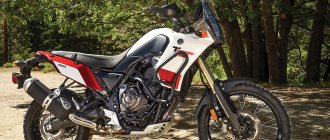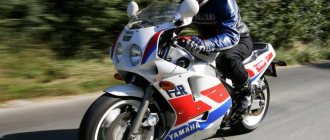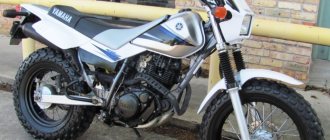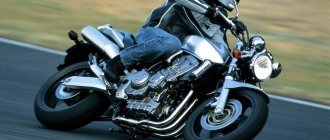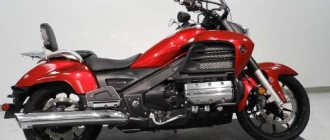001_MOTO_0810_034
Yamaha FZS1000 Fazer: neoclassic, 2001–2005, 998 cm³, 143 hp, 160–270 thousand rubles.
Yamaha FZS1000 Fazer: neoclassic, 2001–2005, 998 cm³, 143 hp, 160–270 thousand rubles.
Combining incompatible things is in the tradition of Japanese motorcycle manufacturers. In the late 90s, when mentioning “classics,” the image of a heavy “elephant” with a flimsy frame, thin fork, mediocre handling and an ancient engine arose. The models have not changed for almost decades. Yes, it seems like there was no need for high-tech, since the main buyers of such equipment have always been considered sedate guys who just want a leisurely ride on the weekend and a breath of fresh air. But it was then, in the middle of the last decade of the 20th century, that work began on developing a new type of classic motorcycle - aggressive, powerful, modern, but at the same time comfortable and practical. One of the first signs was the FZS600 Fazer. A motorcycle with an engine from the “sports tourer” YZF600 Thundercat and an aggressive and eye-catching design literally blew up markets all over the world! It was then that the final separation of a fresh branch of neoclassics (now called roadsters) from the thick trunk of classic motorcycles took place. The experiment turned out to be so successful that the appearance of the older brother of the 600th Phaser was as obvious as poplar fluff in June.
Video
- Review of the Yamaha YZF600R Thundercat motorcycle.
- Review of the Yamaha YZF600R Thundercat motorcycle.
Yamaha YZF600R Thundercat
- a motorcycle with a big name and a glorious history. In the CIS countries, it is still popular for its good driving characteristics, despite the fact that it has been discontinued for a long time, and the nickname “Gromokot” has firmly stuck to it, which is, in fact, a copy of the original name. Be that as it may, this sportbike is very interesting in our time, despite the fact that from a technical point of view it is inferior to its descendants in all respects. And during the years of its production it did not shine with any innovative technical solutions, which did not prevent it from becoming very popular.
The Yamaha YZF600R Thundercat was produced from 1996 to 2004, and despite the fact that this model was developed as a pure sportbike, it turned out to be excellent for fairly short trips, so many owners use it as a sports tourer, and consider it the motorcycle is exactly for this class. It should be noted that the YZF600R Thundercat lost its position as a radical sports bike after the advent of new generation sports motorcycles, more modern and powerful, but it remains relevant to this day.
Having replaced the obsolete Yamaha FZR 600R on the assembly line, the new model was to the taste of customers. The designers inserted a heavily redesigned liquid-cooled inline-four from the aforementioned FZR 600R into the steel frame (deltabox type) of the motorcycle, which after all the modifications significantly increased power and torque. The frame, by the way, is also actually a heavily redesigned frame from its predecessor, as is the aluminum swingarm. As a result, the YZF600R Thundercat turned out to be heavier than the FZR600R, but noticeably more powerful.
Externally, the Yamaha Thundercat resembles its older brother - the YZF1000R Thunderace model, and since the design of motorcycles from this manufacturer has always been their strong point, the Thundercat looks nice and attractive even now. An interesting technical solution was the installation of inertial charging, thanks to which engine power increases with increasing speed. The motorcycle also gets excellent brakes from the YZF1000R.
The brakes, by the way, were just right - the Gromokot is distinguished by impressive dynamics and frantic acceleration. Its 16-valve engine develops a power of 100 hp. (at 11,500 rpm) and is capable of accelerating the motorcycle to an impressive 260 km/h. not bad for a sporty 600 developed several decades ago, right? Moreover, the detonation when opening the gas is very noticeable - this is due to the carburetor power system and the lack of high-tech “gadgets” in the engine. However, its perky character is one of the reasons why the Yamaha YZF600R Thundercat is still so loved by an entire army of fans.
Of course, in the 2000s, “Gromokot” began to yield to more modern competitors, but, as we said above, many motorcyclists fell in love with it as a sport-tourist. This is due to the softness of its suspensions - they are definitely not stiff enough for aggressive driving on the track, but they are excellent for long trips on Russian asphalt. The comfortable dual seat of the Yamaha YZF600R Thundercat allows both the driver and the passenger, if equipped, to sit comfortably. A gas tank with a volume of 19 liters provides a good power reserve - at a speed of 120-130 km/h, the motorcycle fits into 6 liters of gasoline, although the exact consumption value also depends on the technical condition of each specific motorcycle.
Thus, the motorcycle, discontinued back in 2004, is still very popular in the secondary market. It boasts impressive power, a comfortable chassis, excellent, without exaggeration, brakes and a solid power reserve. It is not surprising that many Yamaha Thundercats are still roaming the roads - the motorcycle, according to reviews, is very reliable, so this model will continue to be on sale.
002_MOTO_0810_034
And so in 2000, on the threshold of a new century, Yamaha presented the “big” Phaser to the public. Based on the success of the “six hundred”, they no longer began to save money and be careful with the “liter”. The engine is not from some ancient “sport tourer”, but from the company’s flagship - the R1 superbike! A rigid duplex frame made of chrome-molybdenum pipes, brake mechanisms from the same Erka... In general, the motorcycle turned out to be truly at the cutting edge of technology. If you believe the saying about risk and champagne, then the creators of the “phaserliter” probably took baths with this drink. The motorcycle has gained simply phenomenal popularity all over the world! Other motorcycle manufacturers, both Japanese and many Europeans, quickly followed in Yamaha’s footsteps, but no one was able to catch up with the Phaser in popularity. What can we say if, for example, Honda released a motorcycle based on the “phaser” recipe only this year. The CBF1000, of course, is far from fresh, but Honda dared to stick the engine from a flagship sportbike (and that of the previous generation) into the frame of an ordinary “classic” (and not an evil naked bike) only in 2010.
When preparing materials for the “Dossier,” I almost always start searching for information about a motorcycle with its family problems. Imagine my surprise when the Yamaha FZS1000 Fazer did not have any of these! Fazer is truly one of the few motorcycles without chronic diseases. Plus, it's truly versatile. Although some shooters complain about the discrepancy between the capabilities of the engine and the chassis, in reality it is high time for them to switch to “Erks” and “fires”. 99% of users will disagree with them. The rigidity of the steel duplex frame, 43 mm fork and aluminum pendulum is quite enough for everyday city driving, and for high-speed shooting on the highway, and even for riding on the track, of course, in an amateur format. The FZS1000 is one of the best touring classic motorcycles. A wide and fairly low saddle, a straight seat with a high handlebar and a standard windshield make long-distance voyages easy and enjoyable, and the “sport” engine, derated, by the way, by only 7 horsepower, has smooth traction and tractability at the bottom and in the middle, almost without losing the sporting “spite” at the top. The standard windshield does its job well up to approximately 180–190 km/h. Does anyone drive faster in a long distance? In this case, the aftermarket offers a bunch of options for touring glasses and, by the way, central and even side pannier systems. The “tourist” portrait of the “Phaser” is completed by the presence of a central stand in stock and a powerful head light, by the way, all from the same “erk”.
Review of the Yamaha FZS 600 Fazer motorcycle
Appearance:
Still doesn't look old. Some people don’t like the design, but it’s a matter of taste.
Landing:
Direct landing, with a wide steering wheel is very comfortable. Of the minuses, the seat is not adapted for long-distance driving - 200 km and already the 5th point is starting to sink.
Engine:
There is a pick-up of power after 7 thousand revolutions, not as sharp as in sports, but still there. In the rear it gets up from the gas in 1st and 2nd. I heard the maximum speed was 235 for many, but I couldn’t get more than 220, but there was a small reserve. Acceleration is not bad, but it doesn’t go from low to low (up to 7 thousand), you need to shift it down for sharp acceleration. The engine may make a clattering noise - this is normal.
Suspension:
Quite soft, stability is average, but sufficient. Handling at low speed is amazing, at high speed it’s worse. Quite tall, rarely scratches the bottom. In terms of reliability - like everyone else.
Brakes:
The brakes are from R1 and stop great. True, replacing discs and pads can cost a pretty penny.
Aerodynamics:
In fact, there is none. It's still a classic. The muzzle protects something unknown - the wind still blows in the face. (it is possible to install a touring lobash) At a speed of over 200 it almost takes off. I feel the side wind strongly.
Maintenance and riding:
This is a high-quality and branded motorcycle - it's worth the money. For a student like me, the cost of new parts is sometimes scary. There are analogues, but they are difficult to find and there are not enough for everything. There are a lot of showdowns. The consumption is quite low in my opinion. About 6.5 liters at average pace and traffic. If you heat it all the time, it will definitely eat up its 10. 18 liter tank is enough.
Reliability:
Not a Honda, of course, but overall not bad - no special problems arose.
Driving sensations:
The motorcycle is more youthful. The character is bright and ostentatious.
First, I’ll dispel a few myths about Yamaha and, in particular, about the Phaser. Although, I’ll make a reservation right away, I’m writing only touching my device. Perhaps others have had these problems. So, let's begin:
1. My Fazia doesn’t eat butter. When I bought it in the spring I changed the oil. Now August is the level of norms.
2. There are no problems with second gear either. It all depends on the condition of the device you take. Killed - it will crumble, whole - everything will be OK.
3. Carburetor motorcycle. And there are four carburetors - it’s a pain to set up (if you have to). It’s easy to fill the spark plugs with a suction pump (at least I filled them once, although maybe my hands are growing in the wrong place). I have not encountered or heard of any other problems.
This motorcycle can do everything: ride quietly on business around the city - please, race with sportsbikes at night - please. It goes into reverse with gas in first gear and clutch. On the second - only from the clutch. (And with a passenger and with gas)))). I traveled 650 km on it alone. I drove 140-180 km/h. The entire trip I stopped only at gas stations. And the tank is 20 l. enough for 300 km. I wasn’t tired, just cold – it was April. But I got used to it and warmed my hands on the engine - the motorcycle is naked, you can warm your feet and hands on the engine =). I traveled 1500 km with my girlfriend. She says that it’s very convenient, just scary). Consumption if not frying is about 6-7 liters. The maximum one went was 235 km/h. Didn't accelerate anymore. I did not drive more than 180 km/h with a passenger. It accelerates to hundreds on par with 600cc, liter and other motorcycles. Here the difference in hundredths and tenths of a second is not felt, because more important is who knows how to start and operate the clutch. After 100 there is a difference with liters.
However, Fazia is the most powerful street in the 600cc class. The cb600, diversion 600, katana 600,750, bandit 600, 650 and other classics have fewer horses. I know only one thing that doesn’t suit me about him - his face. Well, I don't like these rectangular headlights. And so everything: comfort and dynamics... The mirrors are excellent, the light... Well, I don’t know what kind of light a motorcycle should have. Seems normal.
This is my first motorcycle. I rode a lot with the Honda cbr600F4. In terms of dynamics, the same thing - that there is a difference of 10 horses - is not noticeable. But the Siberian’s comfort is poor...
Wind protection for me (173cm) is normal. The wind is just above the shoulders; if you bend down, it’s on the top of the helmet, i.e. You can completely hide behind the windshield. This year I also installed a forward flow: carbon AKROPOVICH. Now you can wake up districts at night))). The Fazya starts up in the heat and in the blizzard, it has driven both in the snow and in the sand, and with whomever it has driven, everyone says - yes, your Fazya really drives. No, it all depends on the gasket between the steering wheel and the seat). Maintenance is like any motorcycle - rubber, spark plugs, pads, tires, etc. Everything is like everyone else.
And lastly: is it worth taking or not? If you have money for something newer, I don’t think it’s worth it. It’s better to take something nicer and newer. All the same, years, mileage, technical progress. And after all, now everyone buys a motorcycle to show off, so that girls will like it, to show off, so that at 200 it’s on the back, so that it can do three hundred, and I think that you are no exception... Fazia is not suitable for this. So better take a fresh sport, 600cc or liter. And Fazia... He is not so glamorous and beautiful... But you should take him when your dream is a motorcycle, speed, adrenaline, wind and racing. And you won’t care what others say when you take your owl’s favorite corner with your knee faster than anyone else.
PS. Unfortunately, we have no winding roads, or almost none. I found two while I was flying there, scraping my knees on the asphalt). One grandfather already threatened to hit me with a grenade launcher at 120 km/h)))). In general, I already got the locals))). Especially when Akropovich bought the direct-flow one. Akropovich's sound is so bassy, but sonorous. But not noble, but daring.
This is my first season on this motorcycle. At the moment my mileage is 5800 km. There were two minor falls - some cosmetic repairs were required, but they were done. I was amazed that everything was thought out in order to reduce damage to the motorcycle when it falls. The front turn signals fold, and so do the driver's feet. The front plastic still rubs. But it can also burst if the impact is strong enough. It is necessary to install the arches, otherwise you can break through the side covers. The best option is “Crazy Iron” (the sliders are crap, they are only needed for motorcycles in full plastic, where it is not possible to install bars).
And now about how he drives. He's just a beast! There are rumors that he doesn't have a bottom line - that's nonsense. Having reached an average speed of 4-7 thousand, the engine accelerates normally. From about 8 a noticeable pickup begins - the dynamics become simply crazy. For your information - sports are eaten only at the top! In first gear you can reach 100 km per hour (12.5 thousand), then second and the tachometer needle drops into the pick-up range - and so on up to fifth gear inclusive (sixth gear overdrive - to maintain speed and save gasoline). The acceleration is amazing! Its maximum speed is 240 (with new spark plugs and air filter). I was able to get 225-230 (with the second number 220). The moto steers very easily - it listens to the pilot and understands him perfectly. And the way it turns into a turn is pure pleasure. For your information, but you have to fight with the sport, and make an effort to put it into a turn (everywhere as a sport I compare it with the HONDA CBR 400). The front brakes are simply class (calipers from P1). Once I had to brake very urgently - I was surprised at such possibilities. It happened that I overplayed my hand with pressing the front brake lever - as a result of which there was a second fall. The suspension perfectly absorbs all road irregularities - I drive with heavily inflated wheels (according to the manual: front 2.25; rear 2.6). The front fork did not seem soft to me, perhaps the previous owner filled it with thicker oil.
I really like the mot, maybe I’ll leave it for next season. I really want a new frame (cast alloy), BUT what bothers me is that it cracks when dropped, the front brakes are worse, the bottoms are worse, there is no such glove compartment under the seat and the pipes warm the ass of number two. Among the advantages is a more aerodynamic fairing, an injector (no need to synchronize the carbs), and the bike itself is closer to a sports one... I read all the pros and cons of the phaser in the new frame on the phaser club forum, and not emphasized from personal experience.
Additions: the box is typical Yamaha - loud but clear.
Acceleration: ~3.8 sec to 100 km/h
014_MOTO_0810_034
Typically, recommendations for choosing a specific instance begin with the words: “in addition to standard checks, the same for any motorcycle, you need to pay attention to...”. So, with regard to the Phaser, everything is exactly the opposite: “carry out the standard checks for a used motorcycle.” Fazer really doesn’t have any tricks, pitfalls or family diseases. For the same reason, there is complete peace and quiet when it comes to pricing. The range starts from approximately 160 thousand rubles. for the most well-deserved (it’s hard to say “old”) devices from 2001–2002 and it ends at 270 thousand rubles. for copies of the latest one, produced in 2005.
Design solutions
The appearance of the Yamaha Phaser 600 was in perfect harmony with the stated characteristics.
Every line, curve and design element literally “screamed” about the swiftness and agility of the “steel horse”, fitting perfectly into the original concept of “comfort + versatility”.
The size of the bike allows it to feel great in heavy traffic:
- length - 209.5 cm;
- height - 108.5 cm;
- width - 75.5 cm;
- saddle height - 79.5 cm;
- wheelbase - 144.0 cm;
- ground clearance - 14.5 cm.
Among other things, 17-inch wheels (110/70-ZR17 front and 160/60-ZR17 rear), as well as almost ideal weight distribution along the axles (49 to 51%) add to the maneuverability of the 180-kilogram car.
The high saddle of the motorcycle is ideal for a rider of average height.
Its width allows you to sit with maximum comfort, and the footrests under the seat allow your limbs to be found intuitively.
The paired headlights look like the squinting of a cat's eyes and organically harmonize with other design solutions, while at the same time doing an excellent job with their main task.
A chrome exhaust muffler, a tinted windshield, neat rear-view mirrors, an original-shaped tank and an informative dashboard complement the image of a universal car.
In 2000, the Phaser 600 model underwent modernization aimed at increasing comfort during long journeys. As a result, the motorcycle received an enlarged (up to 20 liters) gas tank. A thicker seat, dual odometer (daily trip), dashboard clock, updated passenger handles, emergency stop signal, improved brakes and other suspension tweaks.
A couple of years later (2002), the tank was enlarged again, stainless steel pipes were installed, the dashboard and fairing were updated, fitting the motorcycle to the updated style of the brand and giving it a more modern look.
005_MOTO_0810_034
ENGINE. A reliable and unpretentious motor is capable of running hundreds of thousands of kilometers without much intervention. The main condition is timely oil change and maintaining its level. A sportbike engine will not tolerate semi-synthetics or even low-quality synthetics and will very soon begin to act up. There have been cases when low-quality oil after 15 thousand km led to stuck piston rings and other unpleasant consequences. Of course, like any Yamaha, the Phaser loves to “eat” oil, and given that it is equipped with 5-valve cylinder heads, this love is even stronger than that of its relatives. A consumption of 0.2–0.3 liters per 1000 km can be considered acceptable. And if it exceeds half a liter per thousand, it’s time to worry about replacing the piston rings and valve stem seals.
006_MOTO_0810_034
TRANSMISSION. The transmission is very reliable and does not require attention. Increased noise during movement, emanating from its depths, is not a sign of a defect, but a design feature, so you should not be afraid of it. The “historical roots” of the box give rise to another feature: gear shifting is much smoother and clearer at high speeds, but at lower speeds it can be harmful. This also should not be suspected as a defect.
010_MOTO_0810_034
Fully adjustable suspension was a rare feature of the classics of the time.
Fazer was one of the first to acquire these sportbike features. Fully adjustable suspension was a rare feature of the classics of the time. Fazer was one of the first to acquire these sportbike features.
SUSPENSION. “Telescope” with a full range of adjustments has a sufficient reserve of energy intensity and torsional rigidity, even for driving on roads with not very high-quality surfaces. The rear suspension monoshock absorber is equipped with adjustments for spring preload and compression and rebound forces. A mandatory and even mediocre “feature” for any sportbike, but how many “classics” can boast of such an arsenal?
Technical characteristics of the Fazer 250 model
Good speed performance is achieved thanks to a four-stroke engine with air cooling and an overhead camshaft. The cylinders are equipped with 2 valves that regulate the fuel supply. The Yamaha Fazer road motorcycle has the following technical data:
- working volume - 249 cubic meters. cm;
- compression ratio - 9.8:1;
- maximum power - 21 hp. With.;
- lubrication system - wet sump;
- clutch - disc, in an oil bath;
- ignition - capacitor, CDI;
- Gearbox - five-speed, constant mesh;
- curb weight - 154 kg;
- length - 2.06 m;
- front brake - hydraulic, single disc;
- rear brake - drum;
- front suspension - telescopic fork;
- rear suspension - pendulum, shock absorber;
- dimensions - 2065x745x1065 mm (LxWxH);
- seat height - 805 mm;
- frame is standard closed duplex.
008_MOTO_0810_034
BRAKES. It’s not without reason that the legendary Sumitomo calipers from the R1 sportbike have been considered ideal for many years. If they were enough even for the ultimate sportbike, let alone the quieter classics. True, although the shape is identical, the brake pads for the R1 and Fazer differ in composition. The latter has a stiffer friction material, which relieves the motorcycle of excessively sharp reactions to lever manipulation and extends their service life. Although for an aggressive driving style, installing “sports” pads may be justified.
011_MOTO_0810_034
LIGHTS. Motorcycles for all world markets are equipped with the same head optics: each headlight has one H4 lamp.
But on many devices, due to the peculiarities of the legislation of the countries for which they were produced, the right headlight only works in high beam mode. Since the H4 lamp is a two-filament lamp, connecting the second low beam is not difficult. It is enough to find an electrical connector under the tank, which has six wires going in and five coming out. The missing wire should be responsible for the right low beam. SADDLE. From a pilot's point of view, the saddle can be called ideal. Moderately rigid, correctly profiled, it allows you to move freely along it in both planes, for example, hanging from a motorcycle on the track, and feel comfortable on a long journey. The passenger seat cannot boast of an excellent rating. Firstly, it is located quite high relative to the pilot’s seat, and a passenger, especially a tall one, literally faces the problem of a headwind. In addition, the footpegs of the second number are located a little high, so that the legs quickly become numb, and the profile of the saddle itself does not allow for proper fixation - when braking, the passenger inevitably slides onto the pilot’s scruff. So only people below average height will be fully comfortable on a long journey.
012_MOTO_0810_034
The dashboard looks rustic by today's standards, but at one time it was the latest in sports fashion.
Readability and information content are excellent. The dashboard looks rustic by today's standards, but at one time it was the latest in sports fashion. Readability and information content are excellent.
GAS TANK. Fuel tank volume - 21 l. At an average speed of 120 km/h, fuel consumption is about 5 l/100 km. So you can cover up to 400 km on one gas station. This indicator can be the envy of many purebred “tourists”! In city driving mode and high-speed shooting on the highway, consumption rarely goes beyond 7 liters, so even if you “spend all your money”, you will have to visit the gas station no sooner than after three hundred kilometers.
PROTECTION. When dropped, engine covers are often damaged as they noticeably protrude beyond the dimensions of the frame. It is better to give preference to arcs. Unlike sliders, the bars are attached to the frame at three points, which makes it possible to distribute impact loads more evenly, while sliders can even cause damage during serious impacts. More than once, the meat slider tore out not only the frame brackets, but also the aluminum “ears” of the engine mounts. Safety bars for the Phaser are produced by many aftermarket companies; their price ranges from $80 to $130.
Distinctive features of the Fazer 250
Yamaha Fazer 250 is a road motorcycle of the same brand, YBR 250, known since 2005, which has undergone restyling. The differences are mainly cosmetic in nature and relate to optical elements and plastic parts. The models are so close to each other that they often appear on the market under the same name, so it is not always possible to accurately determine their actual model range.
The bike seems unassuming at first. But upon closer examination of the Yamaha Fazer, the following design features can be identified:
- rounded plastic elements in the area of the cylinder and rear of the motorcycle;
- tapered waist ergonomic driver's seat;
- a convex headlight that blends harmoniously into the dashboard;
- the “can” of the exhaust system hung with overlays on the right side of the motorcycle;
- transparent triangle-shaped brake light.
Characterized by the following features:
- The 2-valve engine reaches speeds of up to 140 km/h;
- equipped with a forged piston, a cylinder with a low-friction coating, 1 camshaft and 2 valves;
- the cylinder is cooled due to air flows generated during movement, and the oil is also cooled using a small radiator;
- the 8000 rpm engine is designed to produce 21 horsepower - its main advantage is “indestructibility” even under extremely difficult operating conditions and for the toughest drivers;
- the tank is designed for 19 liters;
- service interval - 5000 km;
- lightweight but durable aluminum alloy wheels improve handling;
- the ground clearance of the Fazer 250 allows you to move on various surfaces;
- dynamic appearance;
- fuel consumption – 3l/100 km.
The Yamaha Fazer 250 is suitable for bikers with an A1 category license. It can also satisfy the needs of movement in the city or provide off-road capability. Dealers offer Yamaha motorcycles at affordable prices.
013_MOTO_0810_034
The breakthrough made in 2001 was not wasted.
In 2006, the second generation of “Phasers” saw the light, albeit in a wider composition. The classic model with a semi-fairing received a different index, but retained the same name: FZ1 Fazer. A “naked” modification of the FZ1 Naked also appeared. In five years, progress has come a long way. The younger generation is still equipped with derated engines from the R1, but of the next generation. The much shorter stroke engine produces 150 hp. and is equipped with fuel injection. The archaic duplex was replaced by an aluminum “diagonal”, and the design became even meaner and more aggressive. The second generation of Yamaha neoclassics adopted the main thing from their predecessors - balance and practicality. And, of course, as a result - insane popularity all over the world. This year, another motorcycle of this breed saw the light of day - the 800 cc Fazer. And, apparently, the same glorious fate awaits him as “grandfather.” ESTIMATED COST OF SPARE PARTS Yamaha FZS1000 Fazer
| Name | Original spare parts, rub. | Non-original spare parts, rub. |
| Oil filter | 600 | 350 (Vesrah) |
| Air filter | 1300 | 1000 (Champion) |
| Spark plugs (set) | 1700 | 1500 |
| Sprocket chain kit | 15400 | 6500 (EK/JT) |
| Brake pads (set for two wheels) | 6200 | 4500 (Carbon Lorane) |
| Relay regulator | 4700 | 3000 |
Spare parts, mostly available in stock.
Spare parts are sometimes in stock. Spare parts, mainly imported to order. The motorcycle for shooting was provided by the Z-MOTO workshop. A motorcycle without flaws - Yamaha FZS1000 Fazer
Estimated cost
Today, the Yamaha Fazer 600 model has been discontinued, so purchasing a brand new motorcycle, the main highlight of which was practicality and reliability, is quite problematic.
However, the secondary car market offers the motorcycles in question in fair quantities. The price, of course, depends on the condition and mileage of the equipment, but rarely falls below 200,000 rubles.
A good representative of the Enduro class is the Japanese motorcycle Suzuki Djebel 200.
We also recommend paying attention to bikes from English manufacturers Triumph. You can familiarize yourself with the model range in more detail here.
